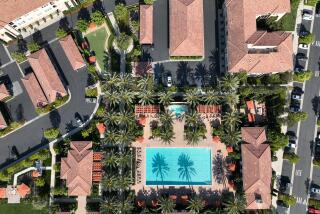West’s Mid-Sized Cities, With Best of Both Worlds, Ride Wave of Growth
- Share via
PROVO, Utah — Jerry and Judy Martinez scouted New England, the Great Lakes region and most of the West, looking for the best place to settle down and open a Southern-style restaurant.
The West was breathtaking, the Louisiana couple decided, but Utah had looks and personality--especially central Utah’s Provo-Orem area.
“When we hit the valley here, I loved it, Judy loved it, and here we are,” Martinez said over gumbo at his new Shoney’s restaurant in Provo.
They’re not alone.
The sister cities of Provo and Orem are drawing newcomers faster than you can say “Oh, my heck!”--as so many residents do in this clean-cut and thoroughly Mormon corner of the world.
The area is riding a new wave of Western growth, one having more to do with the quest for the good life than with old economic imperatives that kept population growth close to the biggest cities.
Prosperity no longer requires building deep-water ports or rail yards so much as attracting the high-tech industries of the rising Information Age.
Such businesses value bottom-line items such as low taxes. But their reliance on a motivated, educated work force also drives them to seek a high quality of life for employees in the form of affordable housing, good schools and recreational opportunities.
Increasingly the places that offer both profitability and livability are small to mid-size cities. They have the best of two worlds: the services and cultural attractions of an urban center without big city crime and expenses, and a more relaxed lifestyle close to nature without rural isolation.
Demographers say the West’s highest growth rates in the next decade may not be in Los Angeles, San Francisco or Seattle, but in smaller metropolitan areas. That means places such as Bellingham, Wash. Or Boise, Ida.
Or Provo and Orem.
This area once claimed fame as the “Steel Center of the West,” thanks to the huge Geneva Steel plant in Vineyard. But now Happy Valley, as locals call it, is looking more like California’s Silicon Valley.
More than 80 high-tech enterprises, including computer giants Novell and WordPerfect, have located here, a concentration surpassed only by Silicon Valley and North Carolina’s Research Triangle, Fortune magazine says.
As for lifestyle, the Provo-Orem area last summer was named the nation’s best place to live in Money magazine’s survey of the 300 largest U.S. metropolitan areas.
The magazine--which considered cost of living, pollution levels, medical services, crime and unemployment--noted that Americans are discovering the wide-open space west of the Mississippi.
In the five years that the magazine has compiled its rankings, top honors have shifted from the coasts to the mountain states and Southwest.
Money called Provo-Orem “a prosperous and easygoing metro area in the Rockies . . . known for unabashed fertility--of its farmland, its Mormon inhabitants and more recently its industrial development.”
The 1990 census counted 263,600 people in the Provo-Orem metropolitan area, up 21% from 1980.
The unemployment rate in Utah Valley is 4.3%, and a typical three-bedroom home goes for $81,000, 18% lower than the U.S. median. There hasn’t been a murder here in two years.
It’s not hard on the eyes either. The valley’s west border is 23-mile-long Utah Lake. To the east, the Wasatch Mountains seem to rise out of back yards.
Of course, there is some culture shock for newcomers. Utah Valley is 96% white and more than 90% Mormon, a religion that emphasizes family life and forbids use of tobacco, alcohol and caffeinated drinks.
But the family focus is no drawback to urban refugees frustrated by drive-by shootings, drug dealers and traffic jams.
Like anywhere else, there is a down side to Provo’s growth and development. Emissions from the steel works and commuters’ cars create a haze of pollution that hovers above the valley nearly all winter.
More to Read
Sign up for Essential California
The most important California stories and recommendations in your inbox every morning.
You may occasionally receive promotional content from the Los Angeles Times.













